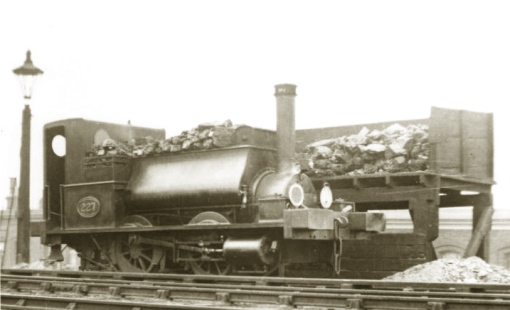Until the advent of James Holden to the chair of Locomotive Superintendent in 1885 the Great Eastern Railway was always short of shunting locos. William Adams ordered a pair of Neilson & Co’s standard 12″ mineral 0-4-0STs in 1874 for shunting depots, wharfs and other places where other locos couldn’t operate due to weight restrictions or small radius curves.
The first to arrive later that year was numbered 209, from which the class received its designation, and was painted in (Adams’ predecessor) S.W. Johnson’s mid-green – a colour he took to Derby. Buffer beams were green and the frames chocolate, and the loco finished off with black bands lined white. A brass number plate sported a blue background.

Number 209 at Stratford Works as delivered from Neilson in 1874, wearing the S.W. Johnson mid-green livery with sprung buffers.
The second loco, number 210, was delivered in 1875 and was almost certainly painted in Adams’ new livery of black fine-lined in red. The cast iron number plates were red with yellow numbers. Both locos had open cabs and were delivered with sprung buffers which were promptly replaced by wooden dumb-buffers.
Two more locos to the same design were ordered by Adams in November 1875 and on delivery the following year were immediately set to work as station pilots at the new Liverpool Street terminus. Numbered 228 and 229, it has been recorded that they were ‘precisely similar’ [sic] to the first pair, but in fact there were some detail changes which included the shape of the frames, the position of the brake standard, the position of the front sandboxes, and the position of the clacks and injectors. As traffic increased in weight at the terminus both were redeployed to Stratford Works as shunters.
In 1894-5 Holden rebuilt all four locos with new boilers and enclosed cabs, but they remained handbrake-only. All four received new front sandb0xes, but those fitted to the original two locos were of a larger design. For the rebuild the original cast iron wheels were retained, as were their wooden brake blocks, and the split brass cottered coupling rods. The opportunity to increase 10cwt coal capacity by extending the height of the bunkers was not taken, and instead three coal rails were added. Ramsbottom safety valves with GER style shrouds were fitted as well as a standard tank filler lid flush with the tank top, and the the space around the steam dome between the bunkers was boxed in.
Under Worsdell, and for the first five years of Holden’s tenure, all locos – goods as well as passenger – were painted in the original vermilion-lined ultramarine blue livery, and there is a photo of a a brand new ex-Works T18 class 0-6-0T with one of the four 0-4-0STs in the background painted so. From 1890 all goods and shunting locos were painted plain black, though somewhat perversely the four 209 class engines were given vermilion lining in the same style as the passenger classes.
In 1897 Holden needed two more locos but this time had them built at Stratford to order number G40, and they were released to traffic in June 1897. Numbers 226 and 227 were basically the same as the 1894 rebuilds of the Neilson engines but with larger sandboxes and cast steel wheels, and although the big ends retained split brasses and cotters, the little ends were plain bushed. In about 1903 they were fitted with a steam brake and a lower standard brake column fitted to clear the cylinder beneath. At about the same time spark arrestors were fitted to the top of the tall chimneys.

No.227 had a short life; built in 1897 and scrapped in December 1911, it’s seen here at one of its regular haunts the Devonshire Street goods depot (later Mile End) sometime after spark arrestors were fitted in 1903. The GER utilised an incredibly complex lights and discs system which at this time ran to 217 codes. 227 displays Ordinary & Special Day Code 41 – white over the coupling hook and green with white rim over the right buffer which signified the loco had worked a train into the Up Reception siding at Devonshire Street. A note in the Appendix to the Working Timetable notes that the code must only be put on at the last stopping station and not carried beyond the depot. The scene with the high timber coaling stage very much resembles what I have in mind for Angel Yard.
In April 1903 two new locos to order R55 with running numbers 230 and 231 were released to traffic with all the modifications inflicted upon the previous six locos, including steam brakes. Holden made a minor alteration to the method of fastening the slide bars to the motion plate which also resulted in the earlier locos being retrofitted when renewal was necessary.
Beyond the time frame of Basilica Fields the eight locos had a varied life, the history of which is recorded in several of the sources below, and fortunately one was preserved and spent many years as a static exhibit at North Woolwich station museum. At the time of writing it has been removed to Gloucestershire for a full rebuild into working order.
In modelling terms there are two kits for the 7mm modeller; one from Ace Products and a soon-to-be-released highly detailed offering from Andy Beaton at Ragstone Models. Andy has shown me the test etchings and the brass investment castings which look super, as well as his final test build and it’s going to be a smashing kit. The loco for Basilica will either be one from the second Neilson batch after the 1894 rebuilding, or one of the 1897 Stratford batch before steam brakes and spark arrestors were fitted in 1903.
- Great Eastern Locomotives Past and Present 1862 – 1945 (Victory Edition) – C. Langley Aldrich
- Great Eastern Society Locomotive Drawings – John Gardner
- Great Eastern Railway Society website